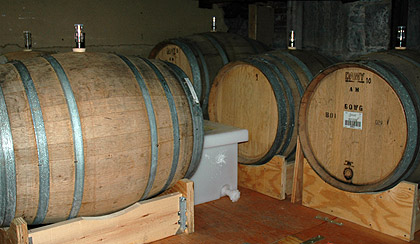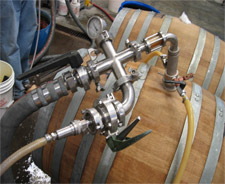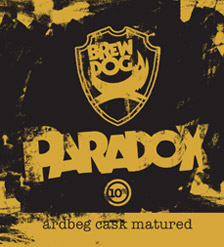
Stephen Beaumont and Jon Abernathy have added their voices to the chorus singing the praises of barrel-aged beers.
Let’s hope everybody is right and more barrel-aged beers are on the way. Right now I’d settle for larger production runs of what’s available.
After writing a story about blending for Imbibe magazine and one about barrel-aging in the current DRAFT magazine I’ve got notebooks full of information that didn’t quite fit and I need to tell somebody about.
Even though I’m still in research mode.
I suggest you start with the DRAFT article. It may be all you need, but should you want more here’s the first of a couple posts on the subject (for now).
There’s not enough to go around
I pointed out how rare these beers are last summer and received several e-mails and comments from people alerting me to barrel-aged beers I might not have known about.
In fact, the number of individual beers being aged in barrels would be quite staggering. Problem is that we are talking a few dozen barrels from a microbrewery here, maybe a single one from a brewpub there. When I was at Berkshire Brewing in Massachusetts last summer I was startled to walk around a corner and see 11 used bourbon barrels (each full of beer) on metal racks.
But the short version of the math I did for DRAFT: Each weekday in USA Today Jerry Shriver recommends a wine. He only chooses wines with a case run of at least 8,000. Why send people looking for something they’ll never find? There isn’t a single barrel-aged beer produced in that quantity.
Consider two upcoming releases.
On Monday, Deschutes Brewery will release the second edition of The Abyss, an imperial stout aged in French oak and bourbon barrels. The first batch (December 2006) disappeared in the blink of an eye. And that’s before the beer was named “Best Stout in the World” by Men’s Journal and won gold medals in several major competitions.
On Saturday, Port Brewing/Lost Abbey will sell Red Poppy Ale for the first time. There are but 60 cases of 375ml bottles, each bottle priced at $15 with a limit will be four bottles per customer. The only way to get the beer is to visit the brewery. Think they’ll have any trouble selling out?
There are barrels and there are barrels
We commonly talk about beer production in terms of barrels, each one amounting to 31 gallons. “The Imperial Brewery just installed a 30-barrel brew house” or “New Belgium Brewing sold 485,000 barrels last year.”
Wood barrels that once contained wine or spirits — or in some cases are being used for the first time — generally hold between 50 and 65 gallons and will yield about two beer barrels.
You might say I lied about nobody producing comparable to 8,000 cases. Firestone Walker ran about 5,000 beer barrels through its Union system last year and sold hundreds of thousands of cases of beer with a measure of oak flavor. The brewery began the year with 36 wood barrels in the Union and boosted that to 42 because of demand.
How it works: The base for what will become Firestone Walker Pale and FW Double Barrel ferments in steel. Approximately 20% is transferred into the Union after the first day of fermentation and that remains in wood for seven days. What’s blended back with beer fermented in steel becomes Double Barrel Ale. The brewers then blend about 15% of Double Barrel with un-oaked pale ale to create Firestone Walker Pale.
It most accurately should be called a barrel-fermented beer, but one that perfectly showcases some of what wood adds. Firestone has released two barrel-aged beers, the cleverly named Firestone 10 and Firestone 11.
There are barrels and there are chips
 To produce 5,000 (beer) barrels of oaked ale to use in blending brewers at Firestone — these are people at work, because this is not a matter of hitting a switch and watching beer flow magically from one container to another — must rack beer into wooden barrels well over 2,000 times, then rack it back into steel after a week.
To produce 5,000 (beer) barrels of oaked ale to use in blending brewers at Firestone — these are people at work, because this is not a matter of hitting a switch and watching beer flow magically from one container to another — must rack beer into wooden barrels well over 2,000 times, then rack it back into steel after a week.
It is ridiculously labor intensive and of course a some beer is lost along the way. It’s hard to believe they can do this and only charge $6.99 to $7.99 a six-pack.
Barrels are a pain in the butt. When I walk into either of two wineries near my house I know I won’t see any barrels. Both use “chips” in the aging tanks to add wood flavor to their products (both red and white wines). They aren’t really chips but wood blocks. The winemakers don’t want too much surface area (which you get with smaller chips) or they’ll end up with excess wood character.
Is this a shortcut? Sure. But it beats the heck out of paying more than $1,000 for a French oak barrel (the going price) and dealing with getting large volumes in and out of barrels that hold 60 or so gallons.
That’s why Anheuser-Busch ages its Winter’s Bourbon Cask Ale in tanks along with bourbon barrel staves rather than the thousands of barrels it would otherwise need. Speaking of people at work, somebody still has to lay those staves in the massive tanks and take them out when the beer is done.
Fine beers are produced using chips, beers like Great Divide Oak Aged Yeti Imperial Stout (French and toasted oak chips) and Stone’s Oaked Arrogant Bastard (which to my taste fares better after it has some time in the bottle).
Oops, that’s more than I intended to write and covered less ground. We’ll resume this soon.
 Now this is getting personal.
Now this is getting personal. Another example would be Paradox from Scottish micro
Another example would be Paradox from Scottish micro 
 To produce 5,000 (beer) barrels of oaked ale to use in blending brewers at Firestone — these are people at work, because this is not a matter of hitting a switch and watching beer flow magically from one container to another — must rack beer into wooden barrels well over 2,000 times, then rack it back into steel after a week.
To produce 5,000 (beer) barrels of oaked ale to use in blending brewers at Firestone — these are people at work, because this is not a matter of hitting a switch and watching beer flow magically from one container to another — must rack beer into wooden barrels well over 2,000 times, then rack it back into steel after a week.